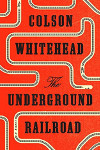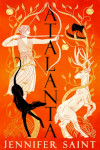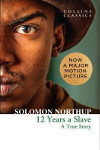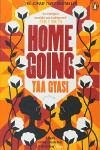Colson Whitehead – The Underground Railroad
Posted 29th October 2018
Category: Reviews Genres: 2010s, Commentary, Fantasy, Historical, Political, Social
1 Comment

A subway before there was a subway.
Publisher: Fleet (Little, Brown)
Pages: 364
Type: Fiction
Age: Adult
ISBN: 978-0-708-89840-6
First Published: 2nd August 2016
Date Reviewed: 29th October 2018
Rating: 5/5
When Caesar approaches Cora to ask her to run away from the plantation with him, she considers it for a short while before agreeing – it’s an incredibly dangerous idea but even her fellow slaves are against her and she feels it is worth the likely death to escape. What she doesn’t know is that Caesar has chosen her due to her own mother’s escape and presumed freedom. They may be able to make it to an underground railroad station and hitch a ride on a locomotive that will take them on the first leg of their journey. The railroad has various stations dotted about the country, and it is up to the individual runaway as to whether they stay in a particular place or return to the train and keep travelling.
(The ‘underground railroad’ is a widely known fact of history in the States – any readers who are from other countries that do not cover the railroad in their general curriculum and don’t know about it, will want to read up on it whether before or after having read the book1.)
The Underground Railroad is a historical fantasy about the American slave trade and slavery, and about the country’s history with race as a whole. Using both history from the slavery era and the further racial discrimination that followed in the decades after abolition, Whitehead’s book is both a stunningly creative look at the country’s growth as a nation, and a fantastic commentary and criticism of the same.
This is very much a plot-and-commentary-driven novel. Whitehead has himself said that his initial idea was of what would happen if the underground railroad had been a real train2. He has also said that this choice to make the fantastical railroad the central element of the book allowed him to play with time and different elements of history3.
The other patrollers were boys and men of bad character; the work attracted a type. In another country they would have been criminals, but this was America.
The book starts at a plantation and shows not only the violence and hatred of the slave owners (the book in general is very violent, with Whitehead including various punishments in a way some primary sources do not, his novel making up for the relative censorship in those books) but the hierarchy and violence that arose as a natural consequence of a situation that caused everyone to be focused on their own survival at the detriment of others. As the train takes Cora – the narrative mostly concerns her – to different Southern States, Whitehead uses these assorted pauses to look at different ideas and acted-out discriminatory practices that were not a part of the exact historical time Cora is living in but were a part of the future decades.
This altering of history creates another fantasy thread in the book, though not nearly as close to ‘fantasy’ as the railroad; Cora steps into situations that you’ll rightly see are at odds with the places that came before it. In one such case, the technology in the State seems too far advanced for a short train journey away. Here, mandatory regular health checks for black people in a state that gives them education, housing (if in a dormitory), and relatively lowly jobs, seem at first a thoughtful acknowledgement of escaped slaves’ trauma… until the doctor offers Cora a not-so-elective-as-described sterilisation, discussing how the state is working on health ideas and performing surgeries on black women who have had a couple of children.
The whites came to this land for a fresh start and to escape the tyranny of their masters, just as the freemen had fled theirs. But the ideals they held up for themselves, they denied others. Cora had heard Michael recite the Declaration of Independence back on the Randall plantation many times, his voice drifting through the village like an angry phantom. She didn’t understand the words, most of them at any rate, but created equal was not lost on her. The white men who wrote it didn’t understand it either, if all men did not truly mean all men. Not if they snatched away what belonged to other people, whether it was something you could hold in your hand, like dirt, or something you could not, like freedom. The land she tilled and worked had been Indian land. She knew the white men bragged about the efficiency of the massacres, where they killed women and babies, and strangled their futures in the crib.
Stolen bodies working stolen land.
Whitehead’s commentary on this and other subjects is incredibly blunt yet never leaves that element of fantasy out; it’s safe to say he’s providing a damning criticism but he does what he can to make you question the reality of different concepts. (Though again, as with the railroad, if your knowledge of American history is solid you’ll probably see a lot more of the facts amongst the fiction without having to look them up.)
And then Whitehead returns to the train and gives you a break for a moment so you can consider what you’ve read and consider what might lay ahead. In a similar way he uses chapter breaks for the different States, and changes the character discussed from Cora to a variety of secondary characters. The novel is written in the third person – with one excellent diversion into first person for Caesar’s story – and mainly concerns Cora; Whitehead changes perspective to give details of a scene that Cora is not privvy to, scenes that further explore the purpose of the novel and add different voices and historical perspectives to it. There are notes about laws, and chapters begin with ‘reward’ notices for anyone who turns in the escaped slave discussed within – these appear to be primary sources.
Backing up the story and the commentary is an unsurprisingly good use of language. Whitehead uses controversial words when warranted; as with everything else this book uses extremes in order to display the history correctly and get to the point.
Certainly you have to suspend some belief for the book – a railroad that stretches for hundreds, maybe thousands of miles, created by slaves and only shut down in sections a long time after it was created (the creation itself being a metaphor) – but no more so than at the end, which will produce in you one (or more) of a few possible conclusions as to what has happened, each in turn adding to the various metaphors and making you question everything you’ve already read.
It’s astounding.
The Underground Railroad is not a book to read with a cosy cup of tea and it’s not one to be rushed (as this library user did when the return date crept up on her). It requires your attention, your time, and in a few places your willingness to search for third-party information. For your efforts you will be handsomely rewarded.
Footnotes
1 The historical reality of the railroad, far from Whitehead’s fantastical re-imagining – that many readers have likened to their initial, childhood, conceptions of it – was a secret network of black people, both free men and women and escaped slaves, as well as supportive white people and Native Americans, who aided the escape of slaves from plantations in the Southern States to states further north, and often as far as Canada. The railroad was a network that traded coded information to allow the movements of escapees to pass between them so that various people could aid their escape – the network had people who would themselves visit plantations, people who would house escapees along their route, and people who would work to disrupt the success of any slave owners or slave catchers from using the law to get people back. I’ve written the basics here – the information in the Wikipedia article on the Underground Railroad should suffice in terms of understanding the background to Whitehead’s re-imagining of the network.
2 ‘Before there was Cora, or any other possible protagonist, I was sittin’ around thinking “What if instead of a metaphor, the Underground Railroad was a real train?” So the concept came first before the characters.’ (Whitehead, 2018)
3 ‘…Once I made the choice to have this central fantastic element of a literal underground railroad, it allowed me to play with time and bring in elements of The Holocaust, the Tuskegee syphilis experiments, and things like that.’ (Whitehead, 2016)
Online References
Whitehead, Colson (2016) Colson Whitehead’s Subterranean Odyssey, Electric Literature, accessed 28th October 2018.
Whitehead, Colson (2018) Re: I’m author Colson Whitehead – just another down on his luck carny with a pocketful of broken dreams – AMA, Reddit, accessed 28th October 2018.
Related Books
1 Comment
Comments closed

























October 29, 2018, 9:23 pm
It’s interesting to read about this book from a non-American point of view. As I said in my review, I found the cruelties almost unbearable to read about, and gave away my copy of the book.